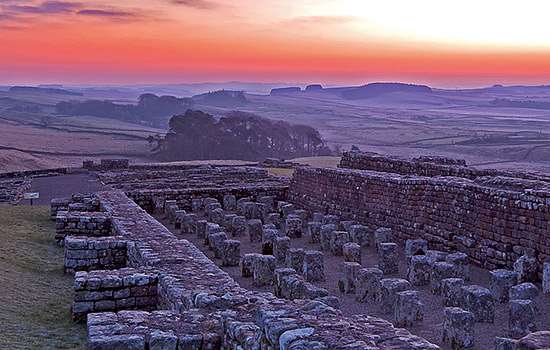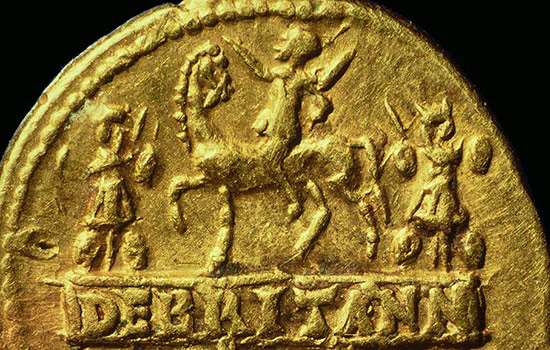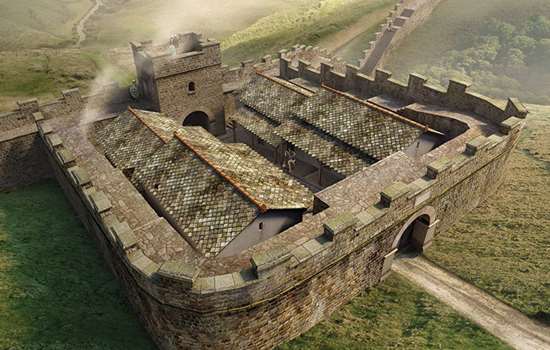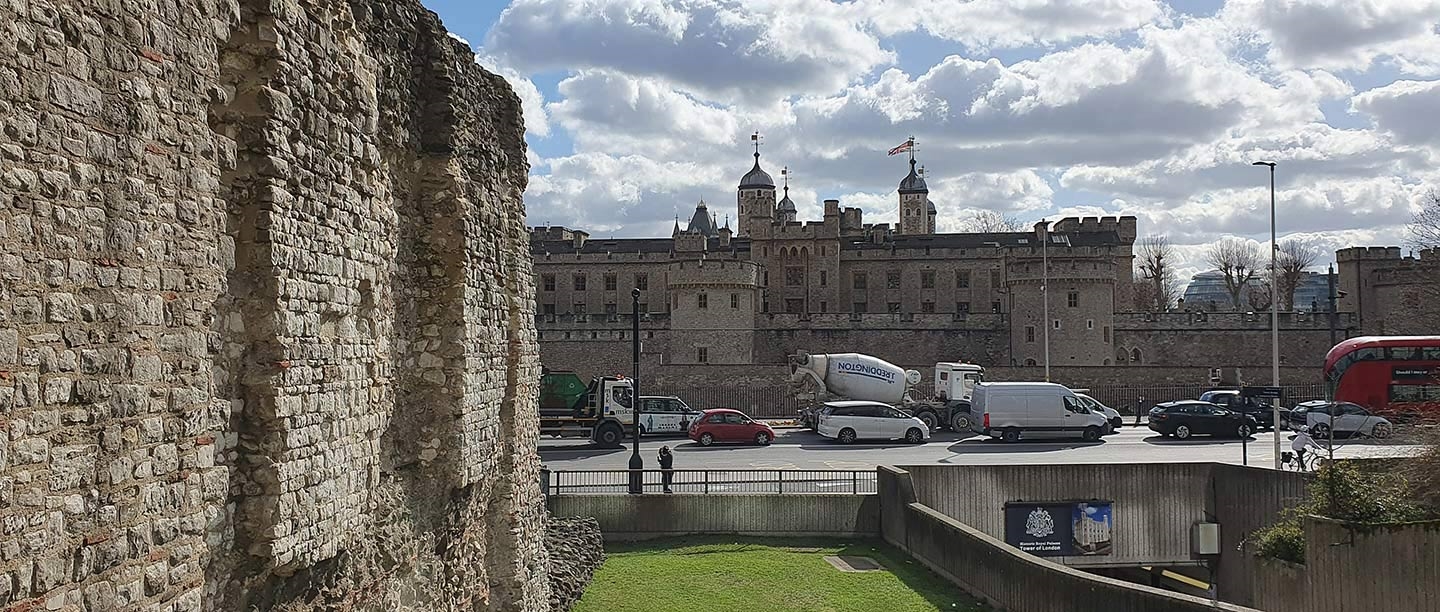The Wall of Roman London
The Romans founded Londinium in about AD 50 at the northern end of a strategically important bridge over the river Thames. Destroyed by fire during the Boudican revolt of AD 60–61, the city was rebuilt and grew into the administrative capital and largest city of the province of Britannia. Its thriving port exploited the influx of trade from the empire and the Romans adorned the city with monumental public buildings, such as a forum and amphitheatre.
The residents built a stone wall around Londinium in about AD 200, although there may have been a much earlier fortification. The wall was roughly 2.5 miles long, enclosing an area of about 134 hectares – making London the largest enclosed urban area in Roman Britain.
The wall was 2–2.6 metres thick at its base and stood over 6 metres high. It was constructed with a core of rubble bound in a hard mortar and faced on either side by roughly squared stone blocks. Every fifth or sixth course was a horizontal band of red tiles, intended to bond the core to the facing stones. In front of the eastern face of the wall was a ditch, which was up to 1.8 metres deep and 4.8 metres across.
The wall originally included four city gates, with an additional entrance at the army’s fortress at Cripplegate on the north-west side. Small square towers, irregularly placed around the circuit, housed access to the walk along the top of the wall. One once stood around 10 metres to the right of the surviving Tower Hill section.
This artist’s impression shows the section of London’s Roman wall near Tower Hill in AD 200. The towers gave access to the walk along the top of the wall – the one in the foreground once stood about 10 metres to the right of the Tower Hill section
© Historic England/English Heritage Trust (illustration by Mikko Kriek)
What was the wall for?
The construction of such a monumental structure was a substantial investment of resources by the residents of Londinium. An estimated 35,000 cubic metres of Kentish ragstone was quarried 70 miles away, near Maidstone, and then shipped via the Medway and Thames to London. The route of the wall would have been cleared of buildings, the ground levelled, and rivers and streams canalised before construction began.
The wall’s form and design demonstrate a lack of urgency, rather than a response to an impending military threat. In places its route ran well beyond the occupied urban area, and the masonry was completed to a high standard, suggesting that speed was not a priority.
Initially the wall only covered the landward sides of the city – a significant omission if it was designed to protect against assault. Walls were also being built around towns and cities elsewhere in the Roman empire during this period of relative peace. Many of the important towns of Roman Britain, such as Camulodunum (Colchester), built similar stone walls, suggesting that they were expressions of wealth and status rather than a response to a threat.
In Londinium, the result was an impressive barrier, defining its boundaries and marking it out to visitors as the most important city in Roman Britain.
The wall and later Roman London
Between AD 250 and 270, a riverside wall was added to the landside wall. This ran for 1,700 metres along the north side of the Thames and completed the circuit of the city.
A likely reason for its construction was the threat of civil war. Postumus, an army general, declared himself Roman emperor in AD 260, in opposition to the emperor Gallienus. He created his own independent ‘Gallic Empire’, which included Britannia. After his assassination in AD 269, it survived under a succession of leaders until Aurelian reunited the empire in AD 274.
In the 4th century, D-shaped bastions were added to the eastern sections of the wall, perhaps in response to sea-borne raiders, such as the Saxons. Catapults or stone-throwing engines could be used from them to protect against attack, like those in the forts along the coast of Roman Britain.
One of these bastions, immediately north of the Tower Hill section of wall, was found to incorporate stonework reused from elsewhere in the city. This included parts of a monument bearing an inscription to Julius Alpinus Classicianus, procurator of Britain AD 61–5, who was responsible for reconstructing London after Boudica’s rebellion of AD 60 and its violent aftermath. The dismantling of this monument may indicate that the wall had to be strengthened in haste in the 4th century.
The medieval wall
The Romans had abandoned Londinium by about AD 450. The Saxon settlement of Lundenwic was established further west, near the area known as The Strand today, and the area within the wall remained largely unoccupied.
In 886 King Alfred reoccupied the city in response to Viking raids along the Thames, and it’s likely that the walls were repaired at this time. They survived to be an important feature of the city at the time of the Norman Conquest of 1066.
Large parts of the Roman wall were incorporated into the medieval defences of the city, which mostly followed the same line. London’s medieval wall rose over 10 metres high, and had extra gates. In about 1300 a new postern gateway – a side gate large enough for pedestrians – was built through the wall immediately south of the Tower Hill section. Watches were kept at the gates, and the guard was often strengthened in response to potential threats to the city, such as rebellions and wars.
The city’s citizens were held financially accountable for the wall, paying ‘murage’ to keep it in good condition. The walls and ditch were a heavy maintenance burden, but they were generally well kept until the English Civil War (1642–51).
A map of the city of London in 1572, with the Tower Hill section of the city wall circled. Most of the city sat behind the wall, and access was only granted at gates such as the postern just to the south, by the Tower of London
© Public domain, via Wikimedia Commons
Destruction and rediscovery
In the late 17th century the wall went into decline. The ditch was drained, and houses were built up against either side. During the 18th and 19th centuries, as London developed into one of the largest cities in the world, it vastly outgrew its wall.
As London rapidly spread eastwards, many of the eastern stretches of the wall remained standing, though largely obscured behind houses. But from the 1840s large sections were destroyed by railway works and later by property redevelopment and road building. Early archaeologists were given opportunities to investigate the wall and discover more about its construction, but they could do nothing to stop its destruction.
The section at Tower Hill only survived as the western end of Trinity Place, a narrow alleyway created in the 18th century. The west face of the wall would have been clearly visible, but the east side was concealed behind the buildings of Jacob’s Yard.
In 1938 the wall and part of the land on its western side were placed in the guardianship of the Ministry of Works, a predecessor of English Heritage. The adjacent buildings were demolished to reveal the wall, which was conserved and restored in the 1940s and 1950s.
Visiting the wall today
The section of wall preserved at Tower Hill shows not only its imposing height in the medieval period, but also its Roman origins. At 10.7 metres above present ground level, it is one of the tallest surviving parts of the circuit. The upper portions and many of the facing stones are medieval, but the lower 4 metres are easily identified as originally Roman by the characteristic horizontal bands of red tiles.
A copy of the inscription from the monument to the Roman procurator Classicianus, found in the bastion north of this section of wall, is displayed in the concrete wall nearby, close to where it was found. The monument itself is in the British Museum. The statue that welcomes visitors is a copy of a Roman statue believed to be of the emperor Trajan (r. 98–117), who pre-dated the wall.
The medieval postern gate sits at the south end of the underpass leading to the Tower of London. Just to the north of the Tower Hill section, a further lengthy section of the wall can be seen at Cooper’s Row.
Related content
-

EXPLORE ROMAN BRITAIN
Browse our articles on the Romans to discover the impact and legacy of the Roman era on Britain’s landscape, buildings, life and culture.
-

The Roman invasion of Britain
In AD 43 Emperor Claudius launched his invasion of Britain. Why did the Romans invade, where did they land, and how did their campaign progress?
-

Hadrian’s Wall: History and Stories
Discover the history and stories associated with Hadrian’s Wall, the north-western frontier of the Roman Empire.
-

MORE HISTORIES
Delve into our history pages to discover more about our sites, how they have changed over time, and who made them what they are today.
